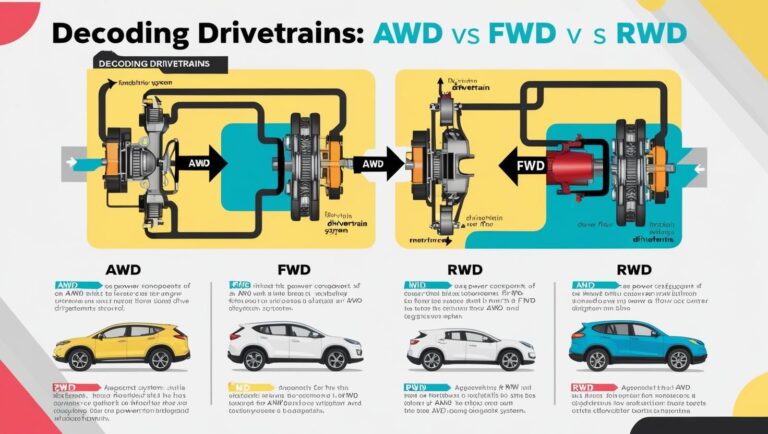In the world of automobiles, understanding how your car operates is crucial, not just for driving performance but also for ensuring safety and efficiency. Among the many technical aspects of a car, the drivetrain is one of the most critical components. It determines how power from the engine is delivered to the wheels, directly impacting handling, fuel efficiency, and the overall driving experience. This article delves into the three main types of drivetrains: All-Wheel Drive (AWD), Front-Wheel Drive (FWD), and Rear-Wheel Drive (RWD). By exploring their mechanics and characteristics, we aim to provide clarity for those in the market for a new vehicle or simply seeking to expand their automotive knowledge.
Understanding Drivetrains: A Deep Dive into Car Dynamics
At its core, a drivetrain is a group of components that deliver power to the driving wheels of a vehicle. This system includes the transmission, driveshafts, differentials, and the wheels themselves. Each type of drivetrain configuration—AWD, FWD, and RWD—distributes power differently, affecting how a vehicle performs under various conditions. Understanding these differences is essential for drivers looking to optimize their car’s capabilities to suit their specific needs and driving environments.
All-Wheel Drive (AWD) is a drivetrain configuration where power is sent to both the front and rear wheels simultaneously. This setup is particularly advantageous in adverse weather conditions such as rain, snow, or ice, where traction is compromised. AWD systems can be either full-time, delivering power to all wheels continuously, or part-time, engaging all wheels only when needed. This versatility makes AWD popular among drivers who encounter diverse terrains, as it enhances stability and control.
Front-Wheel Drive (FWD), on the other hand, channels power to the front wheels only. This configuration is often found in compact and mid-sized vehicles and is praised for its simplicity and efficiency. FWD systems are generally lighter and more fuel-efficient due to fewer components, translating to better mileage. Additionally, because the engine’s weight is over the driving wheels, FWD vehicles tend to have better traction, making them ideal for urban driving and moderate weather conditions.
Comparing AWD, FWD, and RWD: Which is Right for You?
Choosing the right drivetrain depends largely on your driving needs and environment. All-Wheel Drive offers significant advantages in terms of flexibility and safety, especially in climates that experience heavy rain or snow. Its ability to adjust power distribution to optimize traction can be a lifesaver on slippery roads. However, this technology can come at a higher cost, both in terms of initial purchase price and potential maintenance, as the system is more complex than its FWD or RWD counterparts.
For drivers prioritizing fuel efficiency and cost-effectiveness, Front-Wheel Drive (FWD) may be the best option. The lighter design of FWD systems not only enhances fuel economy but also typically results in lower manufacturing costs, making these vehicles more affordable. While FWD may not provide the same level of performance in extreme driving conditions, its reliability in typical urban and suburban environments makes it a popular choice for everyday commuters.
Rear-Wheel Drive (RWD) vehicles, often associated with high-performance and luxury cars, offer a different set of benefits. By delivering power to the rear wheels, RWD configurations allow for better handling and balance, especially at higher speeds. This setup is favored by driving enthusiasts who appreciate the precision and agility it offers. However, RWD can be challenging in poor weather conditions as it lacks the traction advantages of AWD and FWD systems. Ultimately, the decision between AWD, FWD, and RWD should reflect the driver’s personal priorities, be it performance, economy, or adaptability.
Decoding drivetrains is not just about understanding mechanical differences but also about aligning them with personal driving habits and needs. Each configuration—AWD, FWD, and RWD—comes with its own set of advantages and limitations. While All-Wheel Drive is ideal for those who frequently encounter challenging weather conditions, Front-Wheel Drive offers an efficient solution for daily commuting. Rear-Wheel Drive, meanwhile, appeals to those who seek performance and driving thrill. By assessing these options based on environment, lifestyle, and personal preference, drivers can make informed decisions that enhance their vehicle experience.


















